UNIT- 9 Light- Reflection and Refraction
Light Reflection and Refraction
in chapter 9 of 10th class light reflection and refraction we will discuss the phenomenon of light such as reflection and refraction etc.
-
Optics:
It is that branch of physics which deals with the study of light and phenomenon due to light, such as reflection, refraction, diffraction, interference; desperation, polarization and scattering etc. on the basis of nature of light i.e. ray nature and wave nature.
Optics may be divided in to two parts: 1. Ray Optics 2. Wave Optics
- Reflection, refraction, dispersion of light can be explained using ray optics.
- Polarization, interference, Diffraction, etc can be explained using wave optics.
-
Light:
A form of energy which travel in form of radiations with or without medium and due to which vision process is possible is called light.
Form of Light:
- Ray of light :- The path along which light travel from source to receiver called ray of light
- Pencil of light: A group of rays starting from a point called pencil of light.
- Beam of of light: A collection of ray with well defined boundary called beam of light.
-
Reflection of Light:
The phenomenon of bending or re-bouncing back of light in the same medium after striking a reflecting surface (mirror) is called reflection of light. The vision process is possible only due to reflection of light.

Laws of Reflection:-imp
1st Law: The incident ray, reflected ray and normal to the surface lie in the same plane.
2nd Law: The angle of incidence is equal to the angle of reflection.
i.e

- A ray of light incident at an angle 60o .Than what is the angle of reflection?
Ans : 60o
-
Real and Virtual images:-
An image is formed when the light rays coming from an object meet at a point after reflection from a mirror (or refraction from lens).
- The images are of two types
A Real Images:-
Real images are formed when reflected rays of light coming from an object actually meets at a point after reflection from a mirror. Real images can be formed on a screen and can be seen with the eyes.
B Virtual images:-
Virtual image are formed when reflected rays of light coming from an object actually do not meet but seems to meet at a point after reflection from a mirror. It will appear to meet at a point in or behind the mirror .A plane mirror always forms virtual images.
Lateral inversion: –
If an object is placed in front of the mirror, then the right side of the object appears to be the left side and left side of the object appears to be the right side of this image. This change of sides of an object and its mirror image is called lateral inversion.
-
Plane Mirror:
A mirror whose reflecting part is plane called plane mirror.
Characteristic of Image Formed by Plane Mirror:

- The image formed by plane mirror is of same size to that of object.
- The image formed by a plane mirror is at same distance behind the mirror as the object is in front of it.
- Image formed by plane mirror is virtual and erect.
- The image formed by plane mirror is latterly inverted. i.e
6 Some important facts about the plane mirror.
- If the mirror is rotated at an angle θ then image rotates at angle 2 θ.
- The minimum length of a plane mirror should be equal to half of the height of an object to see full size.
- If an object moves toward plane mirror with a speed then image will move toward or away from mirror with speed .
- The linear magnification of a plane mirror is 1 and focal length=∞ and power of plane mirror is O.
-
Spherical Mirrors:
A part of spherical reflecting surface is called spherical mirror. These are of two types:
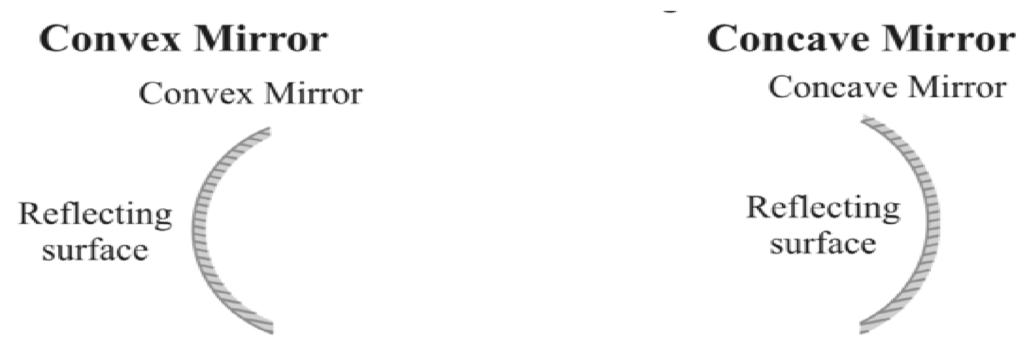
- Convex Mirror:
A spherical mirror whose inner part is polished and outer part is reflecting called convex mirror called convex mirror.
- Concave Mirror:
A spherical mirror whose inner part is reflecting and outer part is polished called concave mirror or a mirror whose reflecting part is toward centre called concave mirror.
-
Application or Uses of Spherical Mirror: imp
Concave Mirror: Dentist, ENT specialist, for saving and make up, in cinema projector, in reflecting type telescope, in solar cooker, in search light, motor head light, in torch, in dish antenna.
Convex Mirror: As rear view mirror, in reflector for street lighting, in big shops to monitor the activities of customers.
-
Some Important Terms Related to Spherical Mirrors:

- Centre of Curvature (C):
The centre of sphere of which the spherical mirror is a part called centre of curvature.
- Radius of Curvature (R):
The radius of sphere of which the spherical mirror is a part called radius of curvature.
- Pole (Vertex):
The midpoint of the spherical mirror is called pole (P).
- Principle Axis:
The line joining the C and P called principle axis.
- Aperture:
The effective diameter of the mirror is called aperture.
- Focus:
The point on the principle axis at which light after reflection from mirror meets or appears to meat called focus (F).
- Focal Length:
The distance between pole and focus of a mirror is called focal length (f).
- Focal length of a spherical mirror is equal to half of radius of curvature of the mirror.
10.New Cartesian Sign Convention for Spherical Mirrors:-imp

- All the distances should be measured from the pole of mirror.
- The distances measured in direction of light are taken positive.
- The distance measured in oppose to direction of light are taken negative .
- The distance measured above the principle axis should be taken positive.
- The distance below the principle axis should be taken negative .
Rules for tracing images formed by Spherical Mirrors
Rule 1: A ray which is parallel to the principal axis after reflection passes through the principal focus in a concave mirror or appears to diverge from the principal focus in a convex mirror.

Rule 2: A ray passing through the principal focus of a concave mirror or a ray which is directed towards the principal focus of a convex mirror emerges parallel to the principal axis after reflection.

Rule 3: A ray passing through the centre of curvature of a concave mirror or directed towards the centre of curvature of a convex mirror is reflected back along the same path.

Rule 4: A ray incident obliquely towards the pole of a concave mirror or a convex mirror is reflected obliquely as per the laws of reflection.

-
Image formed by concave mirror:-
- If object is placed at infinite than the image is formed at the focus. The image will be real and inverted and point sized.

- If object is placed beyond center than the image is formed between center and focus. The image will be real and inverted and smaller in size.

- If object is placed at centre than the image is also formed at Centre. The image will be real and inverted and of same size as that of object.

- If object is placed between centre and focus than the image is formed beyond centre. The image will be real and inverted and large sized.
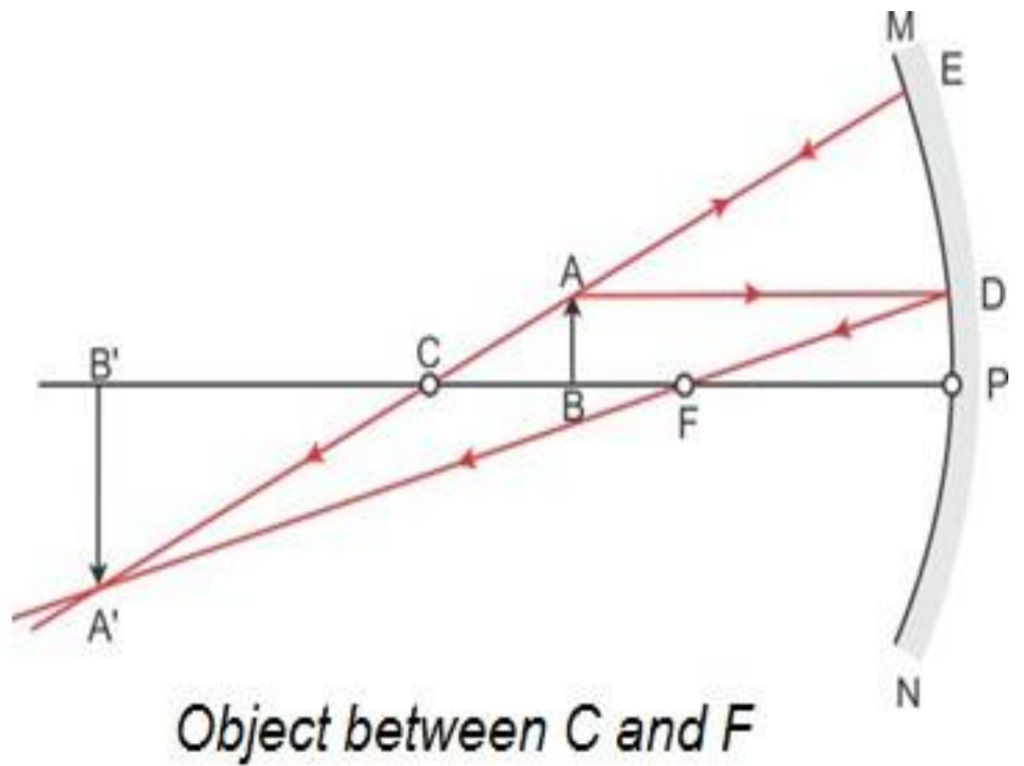
- If object is placed at focus than the image is formed at infinity. The image will be real and inverted and very large sized.

- If object is placed between pole and focus than the image is formed behind the mirror ce. The image will be virtual and erect.

-
Characteristics of images formed
| Position of object | Position of image | Size of image | Nature of image |
| At infinity | At focus F | Highly diminished | Real and inverted |
| Beyond C | Between F and C | Diminished | Real and inverted |
| At C | At C | Equal to size of object | Real and inverted |
| Between C and F | Beyond C | Enlarged | Real and inverted |
| At F | At infinity | Highly enlarged | Real and inverted |
| Between F and P | Behind the mirror | Enlarged | Virtual and erect |
12 Image formed by convex mirror:-
- If object is placed at infinity than image will form at focus. The image will be highly diminished point sized, the image will be virtual and erect.
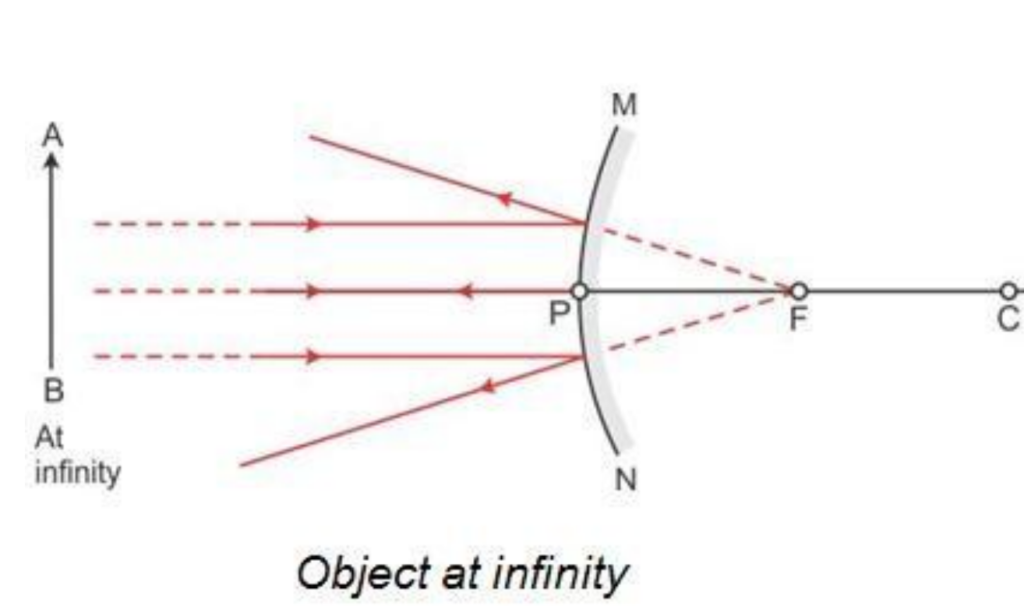
- If object is placed between pole and infinity than image will form between pole and focus. The image will be virtual and erect and diminished
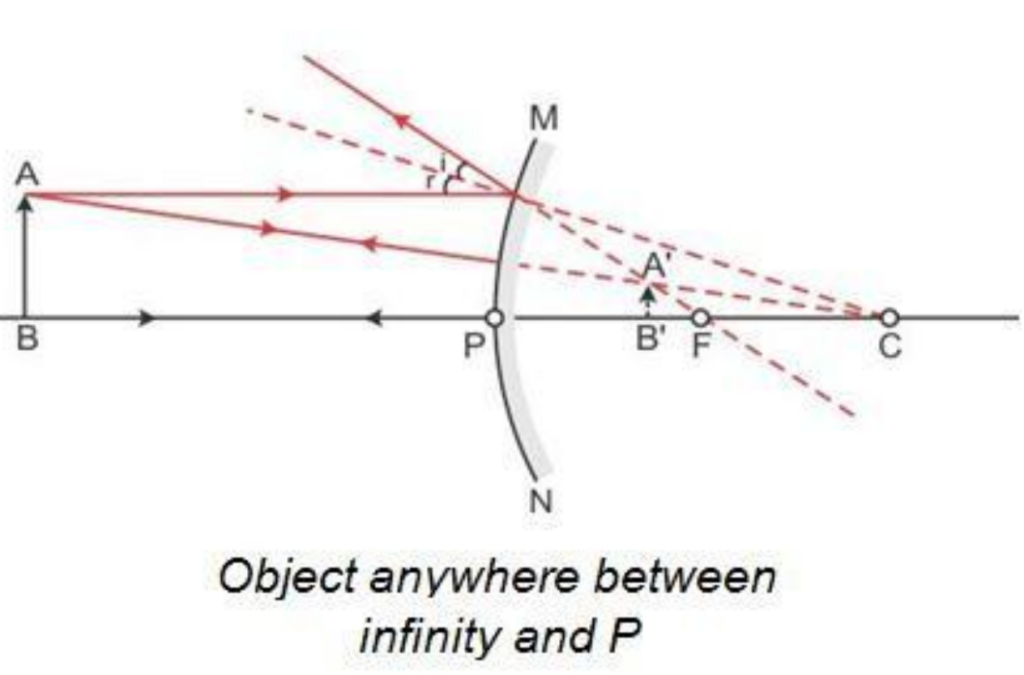
13 .Mirror Formula or Mirror Equation: imp
A relation between position of object u, position of image v and focal length f of a mirror is called mirror formula

14 Linear Magnification of Mirror ( m): imp
It is defiened as the ratio of height of the image to the height of the object
i.e 
If m<1 then image will be smaller then obect
If m> then image will be larger then object.
If m=1 then size of image will be equal to size of obejct (plane mirror)
If m is positive image will be real and if m is negative image will be virtual.
Example 2 An object, 4.0 cm in size, is placed at 25.0 cm in front of a concave mirror of focal length 15.0 cm. At what distance from the mirror should a screen be placed in order to obtain a sharp image? Find the nature and the size of the image.

Question3: An object is placed in front of a concave mirror at a distance of 7.5 cm from it. If the real Image is formed at a distance of 30 cm from the mirror, find the focal Length of the mirror. What Would be the focal? Length if the image is virtual? Solution: Case I: When the image is real. We have u = – 7.5 cm; v = – 30 cm ; f = ?

Case II: When the image is virtual: In this case, u = – 7.5 cm v = + 30 cm
We know ![]()
Question4: An object 5 mm high is placed 30 cm from a convex mirror whose focal length is 20 cm. Find the position (in cm), size (in mm) and nature of the image.
Solution: We have, u = – 30 cm ; v = ? f = + 20 cm
We know ![]()
The image is formed 12 cm behind the mirror, it is virtual.
Now, ![]()
Hence the height of the image = 2mm the positive sign indicates that the image is erect.
Question5: An object 2 mm high is placed 150 mm from a concave mirror of focal length 5 cm. Find the position (in mm) and size (in mm) of the image. 
Question 6. A small candle, 2.5 cm in size is placed at 27 cm in front of a concave mirror of radius of curvature 36 cm. At what distance from the mirror should a screen be placed in order to obtain a sharp image? Describe the nature and size of the image. If the candle is moved closer to the mirror, how would screen have is moved?
Solution: The object is kept between ƒ and C. So the image should be real, inverted and beyond C. To locate the sharp image, screen should be placed at the position of image.

So, the image is inverted and magnified. Thus in order to locate the sharp image, the screen should be kept 54 cm in front of concave mirror and image on the screen will be observed real, inverted and magnified. If the candle is moved closer to the mirror, the real image will move away from the mirror, hence screen has to be shifted away from the mirror to locate the sharp image.
Question 7: A 4.5 cm needle is placed 12 cm away from a convex mirror of focal length 15 cm. Give the location of the image and the magnification. Describe what happens as the needle is moved farther from the mirror.
Solution: A convex mirror always form virtual image, which is erect and small in size of an object kept in front of it. Focal length of convex mirror ƒ = + 15 cm Object distance u = – 12 cm.
Using mirror formula 
Therefore, image is virtual, formed at 6.67 cm at the back of the mirror.
Magnification ![]() so size of the image I= (m×O) =2.5 cm
so size of the image I= (m×O) =2.5 cm
It shows the image is erect, small in size and virtual. When the needle is moved farther from mirror the image also move towards focus and decreasing in size. As u approaches v approaches focus but never beyond ƒ.
Example:8 6 A convex mirrors used for rear-view on an automobile has a radius of curvature of 3 m. If a bus is located at 5 m from this mirror, find the position, nature and size of the image.
Solution Radius of curvature, R = + 3 m;
Object-distance, u = – 5 m; Image-distance, v = ? Height of the image, h′= ?

Example 8: an object, 4.0 cm in size, is placed at 25.0 cm in front of a concave mirror of focal length 15.0 cm. At what distance from the mirror should a screen be placed in order to obtain a sharp image? Find the nature and the size of the image.
Solution Object-size, h = + 4.0 cm; u = – 25.0 cm; f = –15.0 cm; Image-distance, v =? Image-size, h′ =?
From Eq. ![]()
The screen should be placed at 37.5 cm in front of the mirror. The image is real.
Also, magnification, ![]()
Height of the image, h′ = – 6.0 cm the image is inverted and enlarged.
Question9: Find the focal length of a convex mirror whose radius of curvature is 32 cm.
Question10: A concave mirror produces three times magnified (enlarged) real image of an object placed at 10 cm in front of it. Where is the image located?
15 Reflecting of Light:
The phenomenon of the change in the path of light when it moves from one medium to another medium is called refraction of light.

Refraction of light occurs because light changes its velocity when it moves from one medium to another medium. On refraction both velocity and wavelength of light changes but frequency remains unchanged.
-
Laws of Refraction of Light: imp
(i) The incident ray, refracted ray and normal to the surface meet at a point.
(ii) Snell’s Law:
The ratio of sine of angle of incidence to the sine of angle of refraction is constant for a pair of media.
i.e![]()
Here ![]() is called refractive index of second media w.r.t first medium.
is called refractive index of second media w.r.t first medium.
-
Refractive Index: or Absolute Refraction Index: imp
The ratio of velocity of light in vacuum to the velocity of light in a medium is called absolute refractive index or simply refractive index
i.e ![]()
Absolute refractive index may not be less than one because always c>v .
Relative Refraction Index:
Suppose there are two medium of refractive index n1 and n2 then 1n2 called relative refractive of two w.r.t one.

- Clearly smaller, the refractive index of a medium larger the velocity of light in that medium.
- Refractive indexes are a scalar quantity and have no units.
- A medium having higher refraction index called optical denser medium and a medium having lower refraction index called rare medium.
Question11: If wavelength of light in glass is 7200 Å, then find the wavelength of same light (in Å) in water. (nw = 4/3, ng = 3/2)
Solution: ![]()
Question 12: the refractive index of glass is 1.5. What is the speed of light in glass?

-
Principle of Reversibility of Light (Refraction through a Glass Slab): imp
Suppose a ray of light PQ incident at Q point on a glass slab as shown in fig.
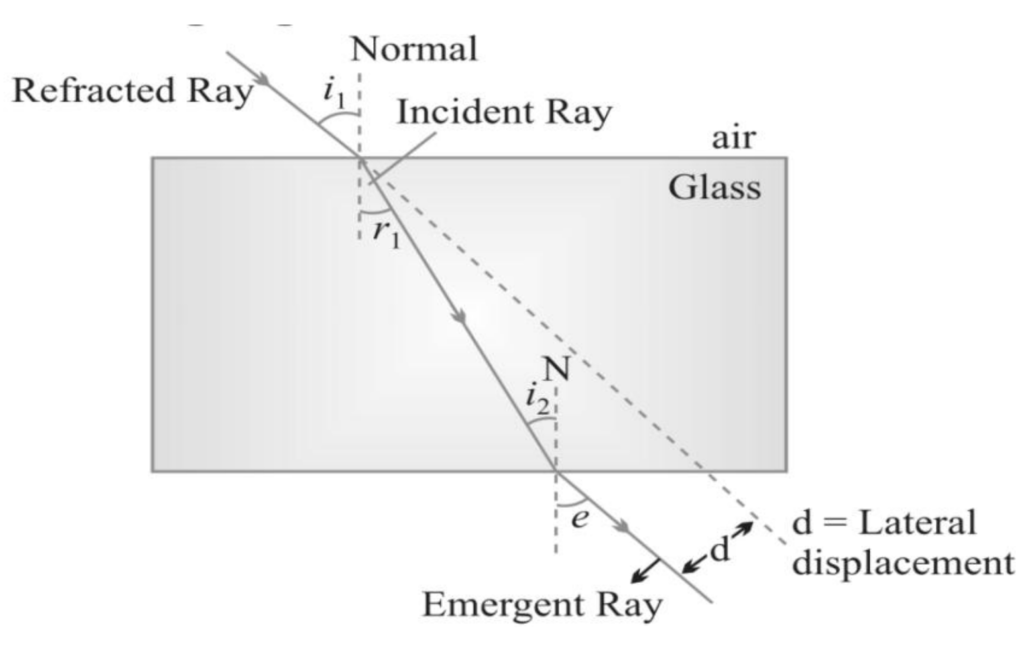
- We can see that when a mirror is placed ⊥ to the path of light, then light regain its original path. This phenomenon is called principle of reversibility of light.
- The perpendicular distance between incident ray and emergent ray is called lateral shift. In above fig. d is the lateral shift.
- Lateral shift increase with thickness of glass slab, increase in incidence angle and refractive index of glass slab.
19.Lens:
A lens is piece of transparent material bounded by two refracting surfaces out of which at least one is curved. Various types of lenses are as given below:

Uses: lenses are commonly used to correct vision deflects in human eyes. They are also used in microscopes, telescopes and cameras, cinemas, photography.
Terms Used in Lenses:
Optical Centre: The point in the lens through which the light passes un-deviated.
Principle Focus (F): The point on the principle axis on which the rays parallel to principle axis after refraction meats or appear to meet.
20 Convex lens:-
A transparent medium bounded by two refracting surface which is thicker at the midpoint and thin at the ends called convex lens.
· 27. Rules for tracing images formed by spherical lens
Rule 1: A ray which is parallel to the principal axis, after refraction passes through the principal focus in case of a convex lens or appears to diverge from the principal focus on the same side of the lens in a concave lens.
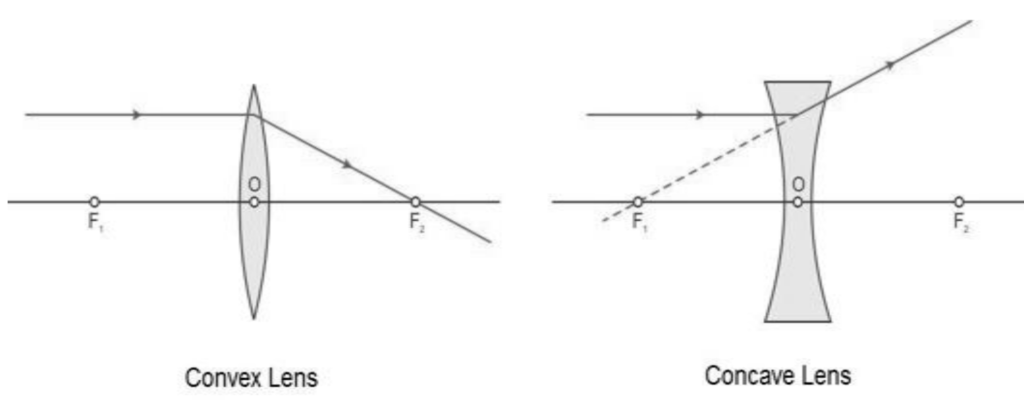
Rule 2: A ray passing through the principal focus of a convex lens or appearing to meet at the principal focus of a concave lens after refraction emerges parallel to the principal axis.
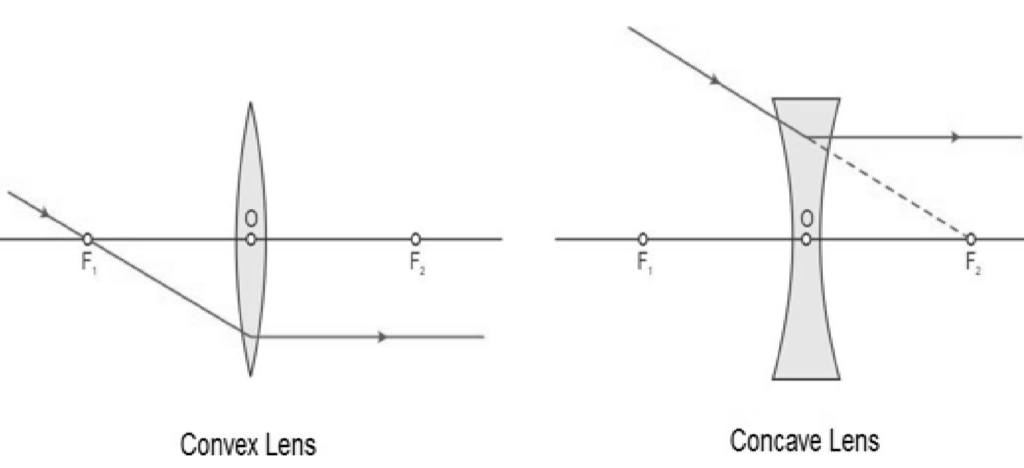
Rule 3: A ray passing through the optical centre of a convex lens or a concave lens emerges without any deviation.
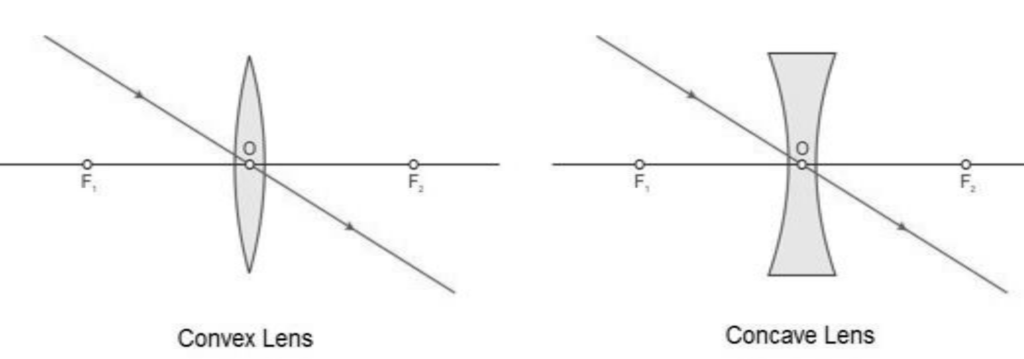
Convex lens makes six images
- If object is placed at infinite than the image is formed at the focus . The image will be real and inverted and point sized.

Image formed by convex lens:-
- If object is placed beyond Centre of curvature than the image is formed between focus and centre . The image will be real and inverted and smaller in size.
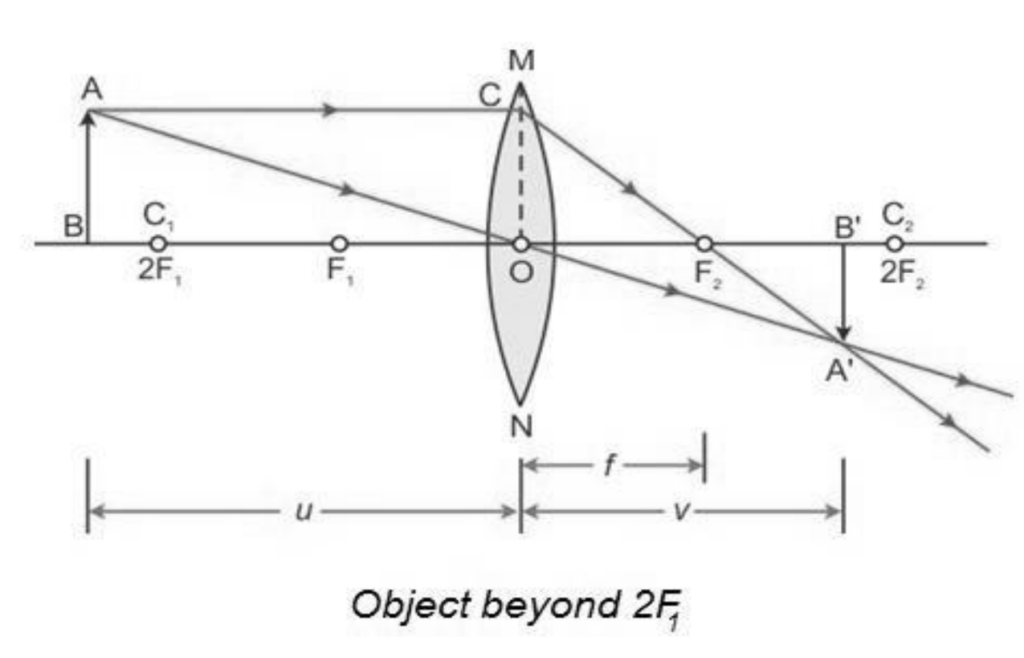
- If object is placed 2F1 at than the image is formed at 2F2. The image will be real and inverted and of same size as that of object.
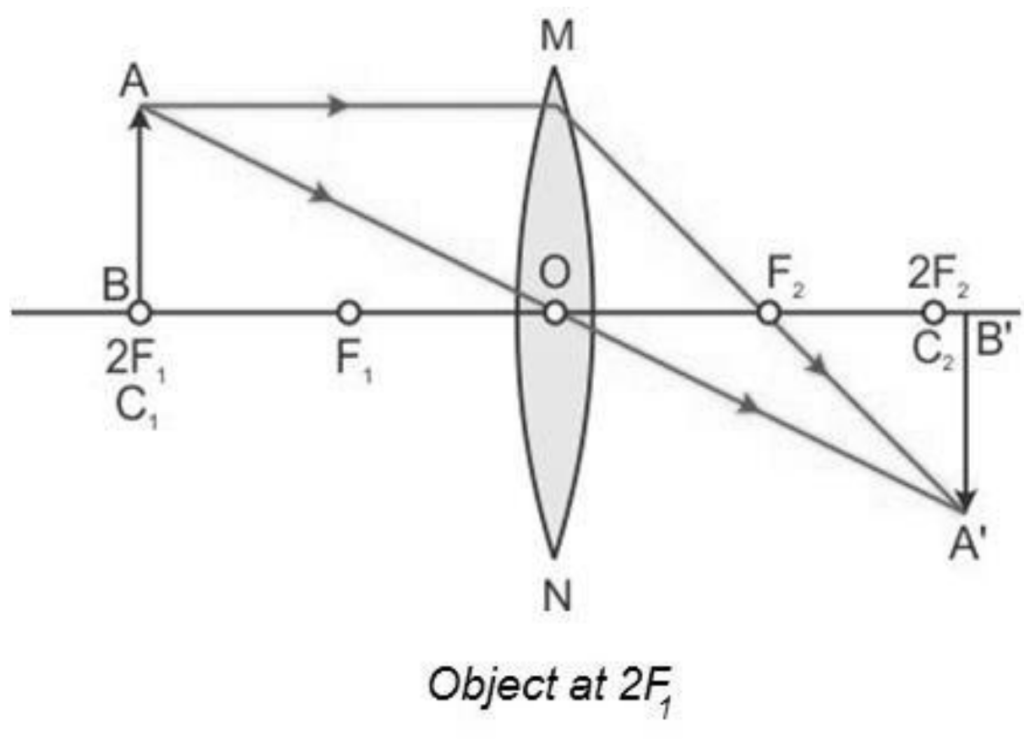
- If object is placed between 2F1 and F1 than the image is formed beyond2F2 . The image will be real and inverted and large sized.
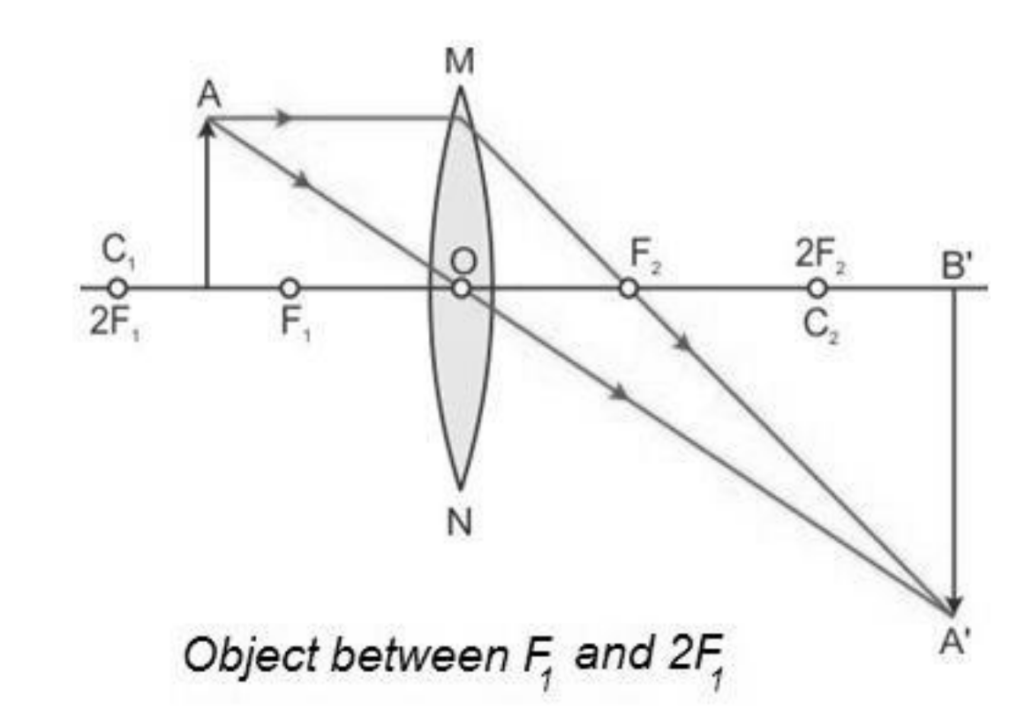
- If object is placed at F1 than the image is formed at infinity. The image will be real and inverted and very large sized.
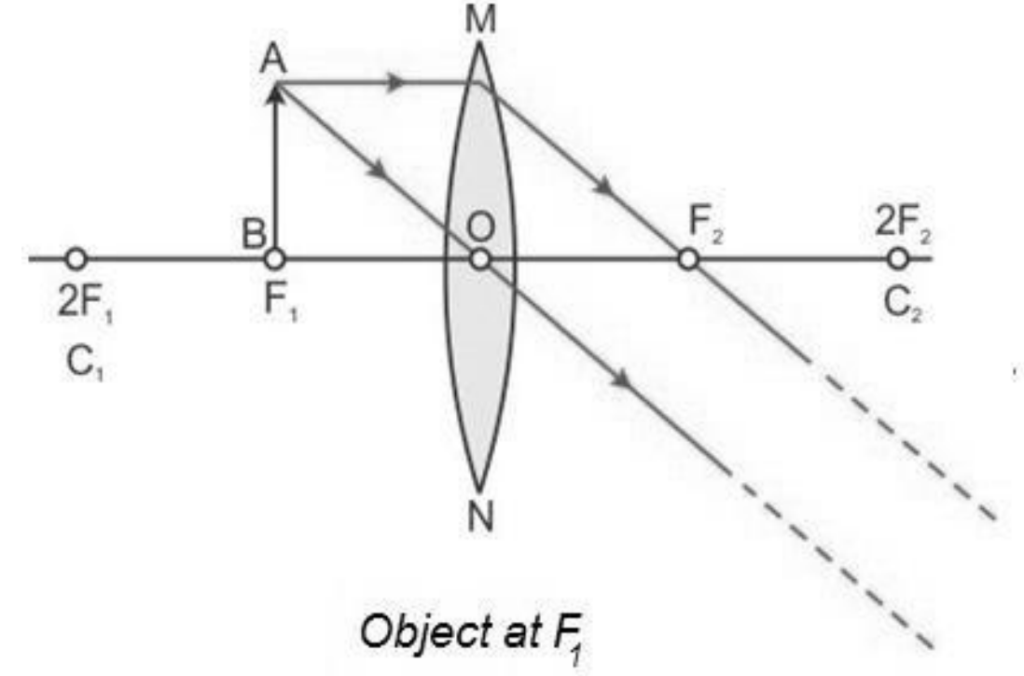
- If object is placed between pole and Centre than the image is formed behind the lens. The image will be virtual and erect.
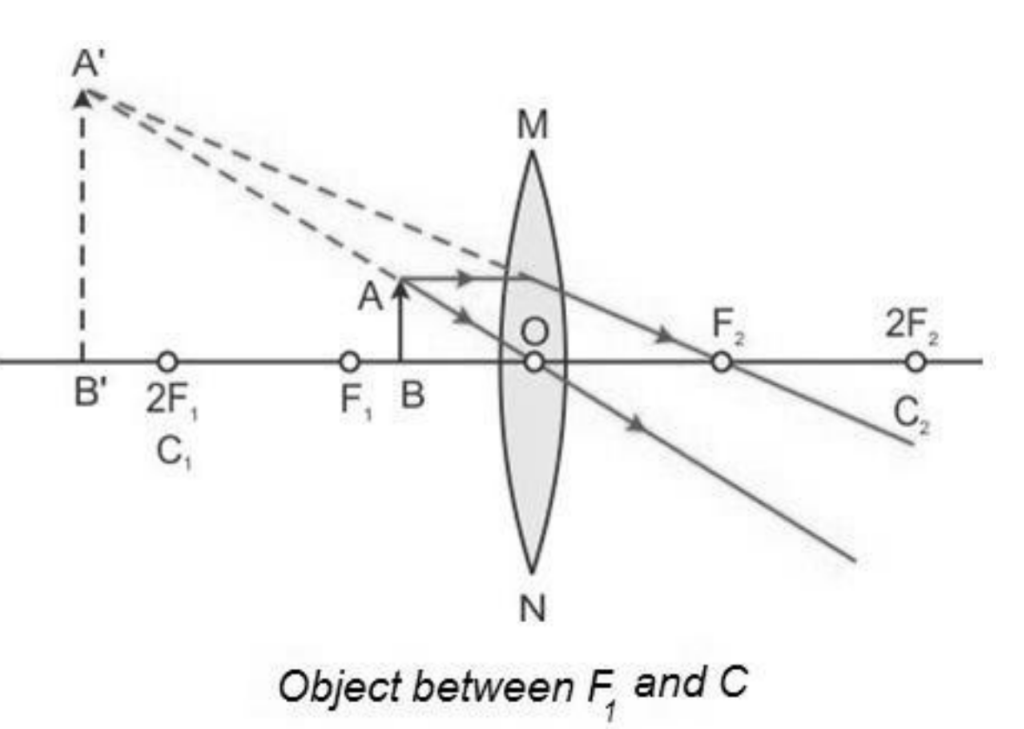
- 29.Characteristics of images formed
| Position of object | Position of image | Size of image | Nature of image |
| At infinity | At focus F2 | Highly diminished | Real and inverted |
| Beyond 2F1 | Between F2 and2F2 | Diminished | Real and inverted |
| At 2F1 | At 2F2 | Equal to size of object | Real and inverted |
| Between F1 and2F1 | Beyond 2F2 | Enlarged | Real and inverted |
| At focus F1 | At infinity | Highly enlarged | Real and inverted |
| Between F1 and O | Beyond F1 on the same side as the object | Enlarged | Virtual and erect |
Uses of convex lens:-
- Convex lens is used in cameras for focusing image and for also magnify image.
- In microscopes, magnifying glass
- In eyeglasses for correctness of farsightedness.
21 Concave lens:-
A transparent medium bounded by two refracting surface which is thinner at the midpoint and thick at the ends called convex lens.
Image formed by concave lens:-
There are only two image formed by concave mirror as
- If object is placed at infinite than the image is formed at the focus . The image will be virtual and erect and point sized.
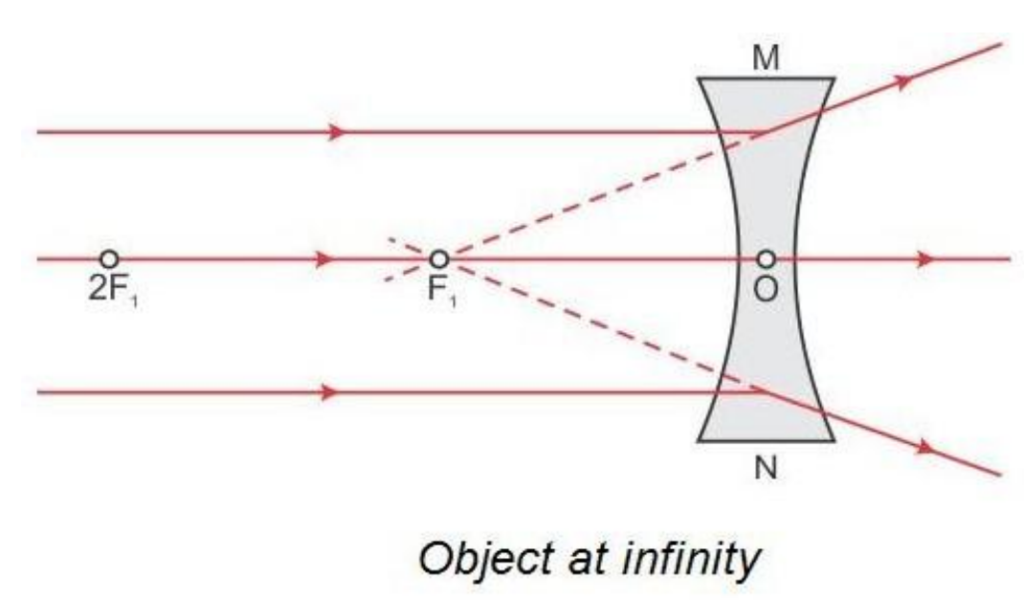
- If object is placed between and than the image is formed between pole and . The image will be virtual and erect and small sized.
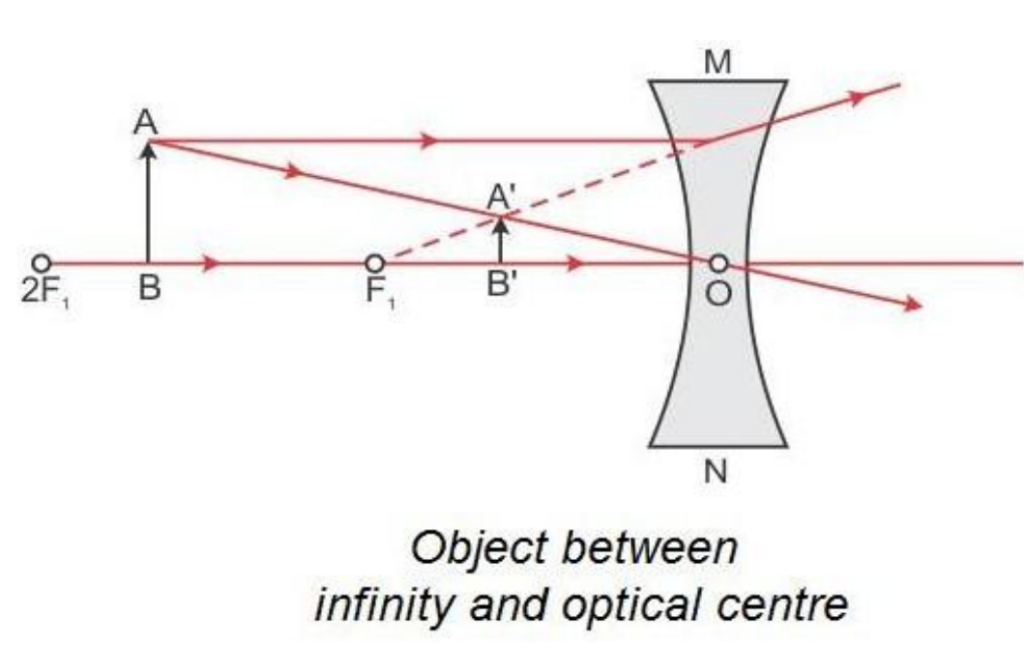
-
Characteristics of images formed
| Position of object | Position of image | Size of image | Nature of image |
| At infinity | At focus F1 | Highly diminished | Virtual and erect |
| Between infinity and O | Between focus F1and O | Diminished | Virtual and erect |
Uses of concave lens:-
- In eyeglasses for correctness of nearsightedness.
- In telescope and binoculars
- In photographic cameras. In flashlight
New Cartesian Sign Convention for lens :
- All the distance should be measured from the Centre of the lens.
- The distance measured in direction of light are taken and in opposite to direction of light are taken .
-
Lens Maker’s Formula: m.imp
A formula, which gives the relation between focal length radius of curvature (R) and refractive index (n ) of the lens is called lens maker formula. It is used to make a lens so called lens maker’s formula.
23 Thin Lens Formula: imp
The relation between the distance of object(u) , image(v) and focal length (f) of a lens is called thin lens formula or lens formula.

This is the lens formula.
24 Linear Magnification:
Linear magnification of a lens is defined as the ratio of size of image to the size of an object. It is denoted by m.
i.e

25 Power of a Lens: imp
The ability of a lens to converse or diverse a beam of light falling on it is called power of lens. It is defined as the reciprocal of the focal length in meter
i.e ![]()
Si unit of power is diopter (D) i.e ![]()
Hence, the power of a lens is one diopter whose focal length is one meter.
Power of convex lens is taken positive and power of concave lens is taken negative
Example 13 A concave lens has focal length of 15 cm. At what distance should the object from the lens be placed so that it forms an image at 10 cm from the lens? Also, find the magnification produced by the lens.

Example 14 A 2.0 cm tall object is placed perpendicular to the principal axis of a convex lens of focal length 10 cm. The distance of the object from the lens is 15 cm. Find the nature, position and size of the image. Also find its magnification. The positive sign shows that the image is erect and virtual. The image is one-third of the size of the object.
Solution here h = + 2.0 cm; f = + 10 cm; u = –15 cm; v =? h′ =?
Since ![]()
The positive sign of v shows that the image is formed at a distance of 30 cm on the other side of the optical Centre. The image is real and inverted.
Magnification ![]()
The negative signs of m and h′ show that the image is inverted and real. It is formed below the principal axis. Thus, a real, inverted image, 4 cm tall, is formed at a distance of 30 cm on the other side of the Lens. The image is two times enlarged.
Question 15. A beam of light converges at a point P. Now a lens is placed in the path of the convergent beam 12 cm from P. At what point does the beam converge if the lens is
(a) a convex lens of focal length 20 cm, and (b) a concave lens of focal length 16 cm?
 Solution:
Solution:(a) The convex lens is placed in the path of convergent beam. Using lens formula
 The image is formed by further converging beams at a distance of 7.5 cm from lens.
The image is formed by further converging beams at a distance of 7.5 cm from lens.

The image I is formed by diverged rays at 48 cm away from concave lens.
Question 16. An object of size 3.0 cm is placed 14 cm in front of a concave lens of focal length 21 cm. Describe the image produced by the lens.
Solution: Object of size 3 cm is placed 14 cm in front of concave lens.

Using lens formula

Formula for magnification =

- Assertion Reason Questions:
- For two statements are given-one labelled Assertion (A) and the other labelled Reason (R). Select the correct answer to these questions from the codes (a), (b), (c) and (d) as given below:
- Both A and R are true, and R is correct explanation of the assertion.
- Both A and R are true, but R is not the correct explanation of the assertion.
- A is true, but R is false. D. A is false, but R is true.
- 1. Assertion: Keeping a point object fixed, if a plane mirror is moved, the image will also move.
Reason: In case of a plane mirror, distance of object and its image is equal from any point on the mirror.
Explanation (a)
The image formed in a plane mirror is at the same distance behind the mirror as the object is in the front of the mirror. Image and the object are at equal distances from a plane mirror.
- 2. Assertion: The size of the mirror affects the nature of the image.
Reason: Small mirrors always form virtual images.
Explanation: (d)
The size of the image does not affect the nature of the image, except that a bigger image as it gathers more tight rays due to wider aperture.
- Case Study Questions:
- Read the following and answer any four questions from (i) to (v).
When the rays of light travels from one transparent medium to another, the path of light deviate, This phenomenon is called refraction of light. The bending of light depends on the optical density of medium through which the light passes.
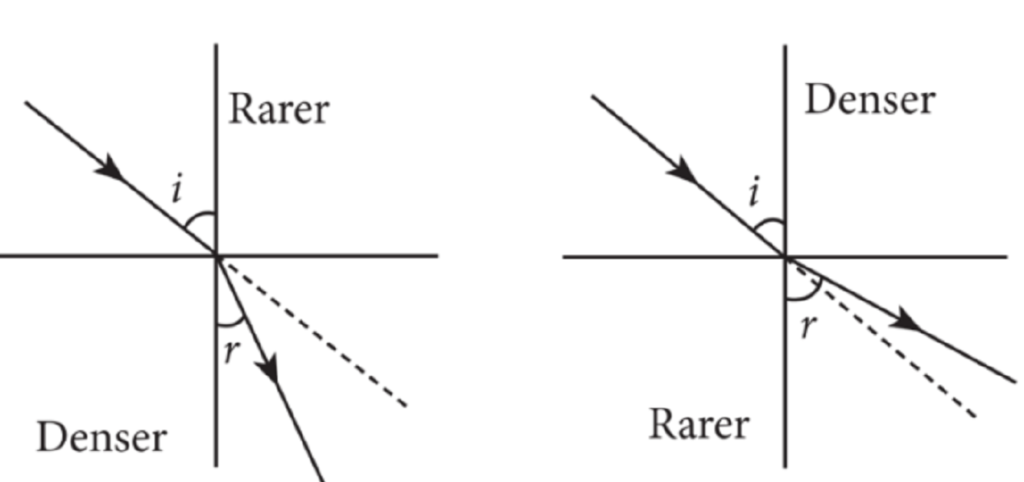
This speed of light varies from medium to medium. A medium in which the speed of light is more is optically rarer medium whereas in which the speed of light is less is optically denser medium. Whenever light goes from one medium to another, the frequency of light does not change however, speed and wavelength change. It concluded that change in speed of light is the basic cause of refraction.
- When light travels from air to glass, the ray of light bends:
(a)Towards the normal (B) Away from normal
(c) Anywhere. (d) None of these.
- A ray of light passes from a medium A to another medium B. No bending of light occurs if the ray of light hits the boundary of medium B at an angle of:
(a) 0º (B) 45º (c) 90º (d) 120º
- When light passes from one medium to another, the frequency of light:
(a) Increases (B) Decreases (c) Remains same (d) None of these
- When light passes from glass to water, the speed of light: (a) Increases. (B) Decreases. (c) Remains same. (d) First increases then decrease.
- The bottom of pool filled with water appears to be due to refraction of light:
- Shallower (B) Deeper (c) At same depth (d) Empty
- The lenses form different types of images when object placed at different locations. When a ray is incident parallel to the principal axis, then after refraction, it passes through the focus or appears to come from the focus. When a ray goes through the optical centre of the lens, it passes without any deviation. If the object is placed between focus and optical canter of the convex lens, erect and magnified image is fanned. As the object is brought closer to the convex lens from infinity to focus, the image moves away from the convex lens from focus to infinity. Also, the size of image goes on increasing and the image is always real and inverted. A concave lens always gives a virtual, erect, and diminished image irrespective to the position of the object.
- The location of image fanned by a convex lens when the object is placed at infinity is
(a)At focus (b) At 2F (c) At optical centre (d) Between F and 2F
- When the object is placed at the focus of concave lens, the image formed is:
(a)Real and smaller (b) Virtual and inverted (c) Virtual and smaller (d) Real and erect
- The size of image formed by a convex lens when the object is placed at the focus of convex lens is:
(a)Small (b) Point in size (c) Highly magnified (d) same as that of object
- When the object is placed at 2F in front of convex lens, the location of image is:
(a)At F (b) At 2 F on the other side (c)At infinity (d)Between F and optical centre
- At which location of object in front of concave lens, the image between focus and optical centre is formed:
(a)Anywhere between centre and infinity (b)At F (c)At 2F (d)Infinity
- Case Study Answer:
- i (a) Towards the normal. ii. (c) 90º iii. (c) Remains same IV. (a) Increases. V. (a) Shallower
- i (a) At focus ii. (b)Virtual and inverted iii. (c) Highly magnified iv (b) At 2 F on the other side
- (a) Anywhere between centre and infinity
17. A convex lens forms a real and inverted image of a needle at a distance of 50 cm from it. Where is the needle placed in front of the convex lens if the image is equal to the size of the object? Also, find the power of the lens.
18. Find the power of a concave lens of focal length 2 m.
EXERCISES
1. Which one of the following materials cannot be used to make a lens?
(a) Water (b) Glass (c) Plastic (d) Clay
2. The image formed by a concave mirror is observed to be virtual, erect and larger than the object. Where should be the position of the object?
(a) Between the principal focus and the centre of curvature (b) At the centre of curvature
(c) Beyond the centre of curvature (d) between the pole of the mirror and its principal focus.
3. Where should an object be placed in front of a convex lens to get a real image of the size of the object?
(a) At the principal focus of the lens (b) At twice the focal length
(c) At infinity (d) between the optical centre of the lens and its principal focus.
4. A spherical mirror and a thin spherical lens have each a focal length of –15 cm. The mirror and the lens are likely to be
(a) Both concave. (b) Both convex.
(c) The mirror is concave and the lens is convex. (d) The mirror is convex, but the lens is concave.
5. No matter how far you stand from a mirror, your image appears erect. The mirror is likely to be
(a) Only plane. (b) Only concave. (c) Only convex. (d) Either plane or convex.
6. Which of the following lenses would you prefer to use while reading small letters found in a dictionary?
(a) A convex lens of focal length 50 cm. (b) A concave lens of focal length 50 cm
(c) A convex lens of focal length 5 cm. (d) A concave lens of focal length 5 cm.
7. We wish to obtain an erect image of an object, using a concave mirror of focal length 15 cm. What should be the range of distance of the object from the mirror? What is the nature of the image? Is the image larger or smaller than the object? Draw a ray diagram to show the image formation in this case.
8. Name the type of mirror used in the following situations.
(a) Headlights of a car. (b) Side/rear-view mirror of a vehicle. (c) Solar furnace.
Support your answer with reason.
9. One-half of a convex lens is covered with a black paper. Will this lens produce a complete image of the object? Verify your answer experimentally. Explain your observations.
10. An object 5 cm in length is held 25 cm away from a converging lens of focal length 10 cm. Draw the ray diagram and find the position, size and the nature of the image formed.
11. A concave lens of focal length 15 cm forms an image 10 cm from the lens. How far is the object placed from the lens? Draw the ray diagram.
12. An object is placed at a distance of 10 cm from a convex mirror of focal length
15 cm. Find the position and nature of the image.
13. The magnification produced by a plane mirror is +1. What does this mean?
14. An object 5.0 cm in length is placed at a distance of 20 cm in front of a convex mirror of radius of curvature 30 cm. Find the position of the image, its nature and size.
15. An object of size 7.0 cm is placed at 27 cm in front of a concave mirror of focal length 18 cm. At what distance from the mirror should a screen be placed, so that a sharp focused image can be obtained? Find the size and the nature of the image.
16. Find the focal length of a lens of power – 2.0 D. What type of lens is this?
17. A doctor has prescribed a corrective lens of power +1.5 D. Find the focal length of the lens. Is the prescribed lens diverging or converging?
To read/ download class 10 chapter 9 light reflection and refraction physics notes click on the link given below
class 10 chapter 9 light reflection and refraction notes
